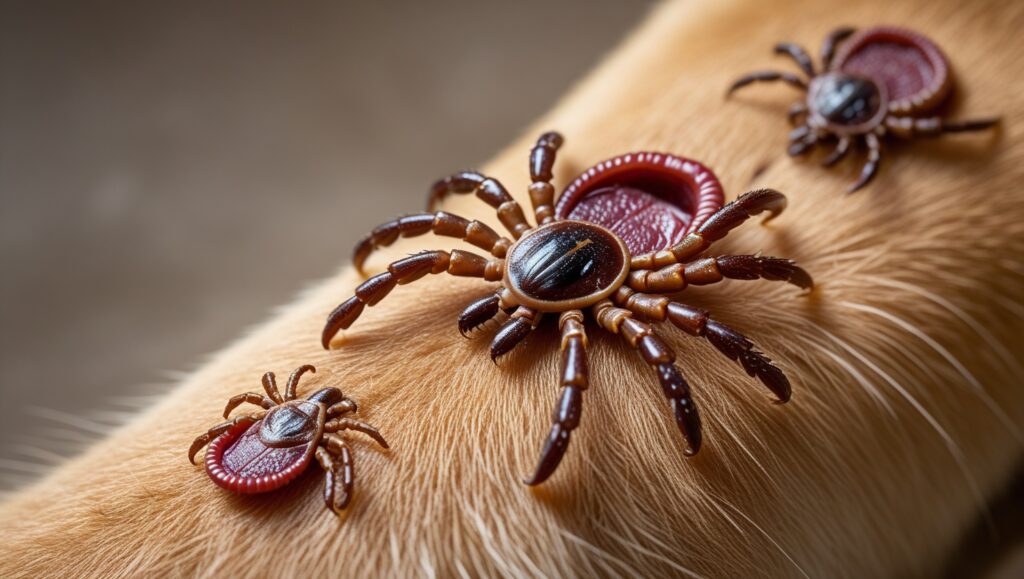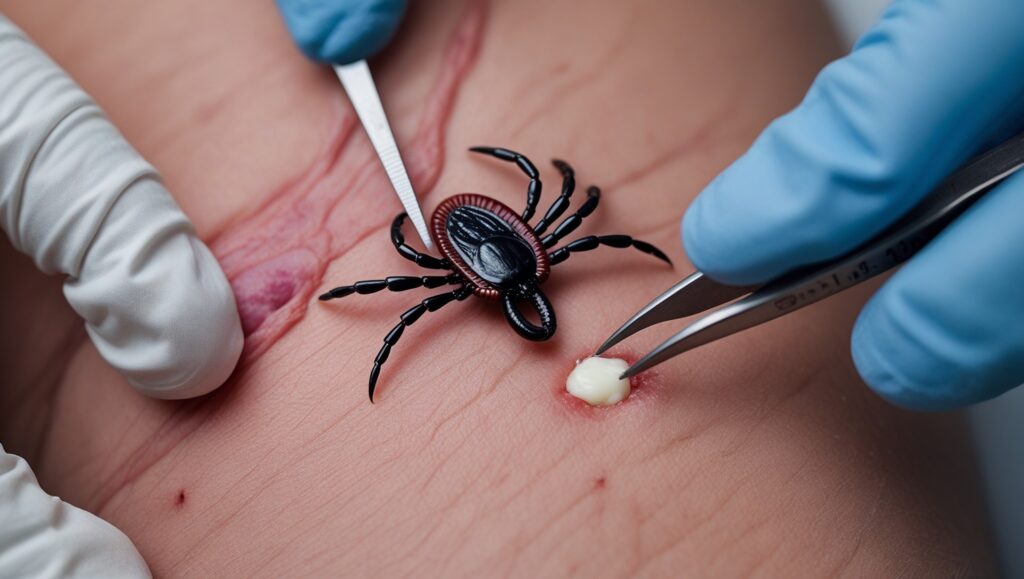Embedded fully ticks on dogs are more than just a nuisance—they can be a nightmare for pet owners. When a tick buries its head deep into your dog’s skin, it can cause infection, discomfort, and even serious disease. Although an easily visible tick on its surface is bad enough, fully embedded ticks on dogs, whereby the head of the tick has been pushed into the skin of the dog, are a greater health risk. In this guide, we will explore what embedded ticks are, how to identify and eliminate them, and how to prevent your dog from contracting another infestation.
Table of Contents

What Is a Fully Embedded Tick on a Dog?
A fully engorged tick is said to be an embedded tick, being the one that has bored its head into the skin of a dog so that it can suck blood. These ticks may not be easy to detect, as only the body of the tick may be visible above the surface or entirely concealed within fur and even skin folds.
Fully embedded ticks on dogs can go unnoticed for several days, as opposed to partially attached ticks that take a short time to be removed. At this period, they enhance the chances of spreading lethal diseases such as
- Lyme disease
- Ehrlichiosis
- Anaplasmosis
- Rocky Mountain spotted fever.
Symptoms Your Dog May Have a Tick Inside
Fully embedded ticks on dogs disseminate deep underneath the skin; hence, physical symptoms and behavioral symptoms should be observed. Underemployment, inflation, and unemployment.
- Scabbing or red, inflamed skin.
- Too much scratching/licking on a single spot.
- Appetite loss or somnolence (in the case of the onset of an infection).
- Influenza and Paralytic Polio.
You spot a dark bump that does not move very easily or looks like a wart but has legs or appears to be swollen—there are high chances that it is a tick.
Removing an embedded tick on a dog safely.
The wrong removal of a tick may result in the detachment of its body parts (particularly its head) that remain embedded inside the skin, where they cause infection. These are the steps for the removal of a fully embedded tick:

1. Gather Supplies
As tweezers or finer-tipped tweezers, or even a tick removal tool
- Gloves
- Chlorhexidine is like an antiseptic solution.
- Sterilizing rubbing alcohol.
2. Wear Gloves
Wear gloves where possible, since they prevent tick-borne disease.
3. Find the Tick and Expose the Place
Using your fingers, separate the fur carefully. Find the body of the tick and be patient in the event it is very deeply planted.
4. Kick the Tick
Using tweezers:
- Drag with a steady pull and not twisting. This helps in taking out the head completely.
- Do not push or compress the tick’s body; it could stimulate the pathogens to escape into the bloodstream.
- When the tick has not gotten off fully, do proceed then to dig in the skin. In case they should be, leave it to a vet.
5. Clean up the Location
Clean the area of the bite with an antiseptic. You may also use an antibiotic cream that is pet-safe.
6. Watch Your Dog
Fever, spots, erythema, and edema/pus appear after a couple of days.
Does that Mean You May need to take Your Pet to the Vet?
Yes—consult a vet, provided always that:
- You could not pull the whole tick out.
- There is edema or infection of the bite site.
- Your dog is sickly.
- There is a series of ticks embedded.
- It is possible that your dog went to Lyme-infested locations.
Tick prevention medications may be prescribed by a vet, and tick-borne infections may be tested in terms of blood by a vet.
How to Stop Dogs from Getting Tick Bites?
The prediction is that prevention is the future of health, to screen for a cure. These are some effective methods for deterring ticks:

Use Tick Preventives
- Topical applications (Frontline, Advantix, etc.).
- Oral meds (Pellosan, etc., NexGard, Bravecto).
- Tick collars (e.g., Seresto).
Inspect Your Dog Daily
After dog walking or playing in the yard/grass:
- Search at the corner of the toes, under the cheeks, under the collar, and above the tail and belly.
- Feel for bumps as well by running your hands through your dog’s coat.
Gardens Tidy
- Cut the grass often.
- Clear leaf piles or trash.
- Put to use a pet-safe tick spray.
Steer Clear Of Ticket Areas
Restrict your dog’s contact with:
- Wooded trails
- Tall fields of grass.
- Densely planted, bushy or marshy spots.
Frequently Asked Questions About Ticks on Dogs
- Myth: You can burn or cover ticks to remove them.
- Fact: Getting rid of the tick in this manner can cause it to emit more toxic bodily fluids into your dog.
- Myth: Ticks only attack canines in summer.
- Fact: Ticks can live year-round if it’s warm or indoors.
Final Thoughts
Ticks not only create food annoyance, but they are also life-threatening parasites that can burrow deep into the skin of your dog and leave a lasting adverse health situation. The knowledge of ways to recognize, treat, and avoid the presence of embedded fully ticks on dogs will be your main focus to keep your fur baby sound and well. Never put off, never use unvetted treatments, and never be afraid to call in a vet should your dog show signs of becoming ill following a tick bite.
What is likely to occur when a tick is not completely removed from my dog?
When the head of a tick is implanted, one may contract an infection, a swelling, and even an abscess. There should never be a time when a vet cannot be called in case the problem concerning the removal of the entire tick is doubted.
What is the maximum amount of time an embedded tick can be on a dog?
Ticks are capable of remaining on their hosts between 3 and 10 days, feeding on blood. The chances of contracting diseases among them become worse as long as they are there.
Is it possible that only one bite from a tick makes the dog ill?
Yes. One infected tick is capable of spreading such serious diseases as Lyme disease. It is therefore important to get rid of ticks as soon as possible and look out for any other signs of illness.




Pingback: Dog Ate a Silica Packet? 5 Life-Saving Steps to Act Fast